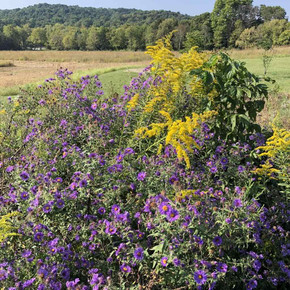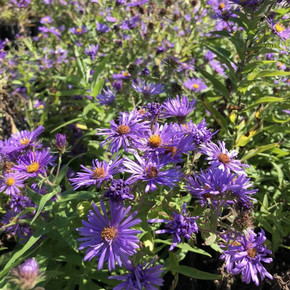
Aster novae-angliae 'Purple Dome' (SYMPHYOTRICHUM) - NEW ENGLAND ASTER 'PURPLE DOME'
New England Aster 'Purple Dome' is short and compact cultivar with dark-purple flowers, reaching only 18-24" of height and up to 3' of width.
‘Purple Dome’ is actually natural form, that was discover in nature - it was first observed along Pennsylvania Route 100 below Allentown, PA by Robert G. Seip of Lennilea Farm and given to Mt. Cuba Center who introduced it in 1989.
Tolerant to black walnut.
Blooming time : August - September/October
USDA zones : 4 to 9
Culture : sun, half sun, half shade, average soil, loam, clay soil
Moisture Needs : medium-wet, medium-moist, medium-dry, tolerates droughts
Origin : Botanical wild form is native wildflower and perennial to most of the states of USA except Arizona, Idaho, Nevada, Texas and Florida.
Deer/rabbit resistant : yes/yes
Attracts Butterflies or Pollinators: various bees and some butterflies. Attracts some songbirds.
Attracts Hummingbirds : no
Pot Size : square 3.5"x 5" deep pot
Plant combinations : Universal perennial for sunny or partially sunny garden for average, moderately fertile to fertile soils. For it's regular mounding habit can be used as a "filler" and can be combined with majority of common and native perennials and grasses. Suitable for flower beds, massive planting, public landscaping and private gardens. Meets in Bloom with other fall Asters, Chrysospis (Ch. villosa, Ch. mariana),Helianthus (perennial sunflowers), many Rudbeckia (R. fulgida var. fulgida, R. subtomentosa and R. triloba), Solidago species and cultivars.
Regular mounds look great against airy and fine structures (Euphorbia corollata, Gaura, Verbena bonariensis) and fine structures of grasses (which often start to change their fall color by that time of the year).
Picture copyright : US Perennials nursery

Aster novae-angliae 'Purple Dome' (SYMPHYOTRICHUM) - NEW ENGLAND ASTER 'PURPLE DOME'
New England Aster 'Purple Dome' is short and compact cultivar with dark-purple flowers, reaching only 18-24" of height and up to 3' of width.
‘Purple Dome’ is actually natural form, that was discover in nature - it was first observed along Pennsylvania Route 100 below Allentown, PA by Robert G. Seip of Lennilea Farm and given to Mt. Cuba Center who introduced it in 1989.
Tolerant to black walnut.
Blooming time : August - September/October
USDA zones : 4 to 9
Culture : sun, half sun, half shade, average soil, loam, clay soil
Moisture Needs : medium-wet, medium-moist, medium-dry, tolerates droughts
Origin : Botanical wild form is native wildflower and perennial to most of the states of USA except Arizona, Idaho, Nevada, Texas and Florida.
Deer/rabbit resistant : yes/yes
Attracts Butterflies or Pollinators: various bees and some butterflies. Attracts some songbirds.
Attracts Hummingbirds : no
Pot Size : square 3.5"x 5" deep pot
Plant combinations : Universal perennial for sunny or partially sunny garden for average, moderately fertile to fertile soils. For it's regular mounding habit can be used as a "filler" and can be combined with majority of common and native perennials and grasses. Suitable for flower beds, massive planting, public landscaping and private gardens. Meets in Bloom with other fall Asters, Chrysospis (Ch. villosa, Ch. mariana),Helianthus (perennial sunflowers), many Rudbeckia (R. fulgida var. fulgida, R. subtomentosa and R. triloba), Solidago species and cultivars.
Regular mounds look great against airy and fine structures (Euphorbia corollata, Gaura, Verbena bonariensis) and fine structures of grasses (which often start to change their fall color by that time of the year).
Picture copyright : US Perennials nursery
Customer Reviews
-
New england Aster 'Purple Dome'
Ordered 6 of these lovelies, as part of my second order this fall - excellent packing, robust looking plants; so far looking happy in our cooler rainy CT weather. Can't wait for their spring emergence, and for my new orders. Thank you!










